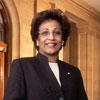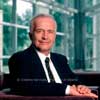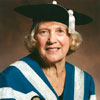The International University (1995-2008)

Over the past century, scientific discoveries, medical advancements, urban growth, changing family patterns and gender roles, human rights, and quantum leaps in communication, media, and technology have caused drastic changes in the University of Alberta.
Often leading educational and research advancements, the University of Alberta has matured into an international organization that is consistently regarded as one of Canada’s top universities. W. John McDonald was acting President from 1994 to 1995 when Roderick Fraser became President.
Under Premier Ralph Klein’s leadership (1992-2007), the Conservative party ruled with the clear intent of getting Alberta out of debt. In the 1990s, there were reductions in government funding with social services, health, and educational sectors' being particularly hard hit.
Under intense government cutbacks, heightened fundraising initiatives were critical to the University. Government fiscal restraints and escalating costs also had a huge impact on University of Alberta students. Students’ Union President Leslie Church, in a holiday message published in ExpressNews December 21, 2000, wrote about the incredible spirit of the University and about soaring tuition fees.
December 21, 2000
Looking back, 2000 was an amazing year at the University of Alberta. I have been privileged to witness numerous occasions where the tremendous outpouring of campus pride has left me astounded and thrilled. From capacity crowds at the first-ever Antifreeze winter carnival, to the awe-inspiring, world-renowned diabetes discovery, and finally to the President's Address in the Hawrelak Amphitheatre before an audience of hollering, candle-waving first-years: U of A students have incredible spirit!
At the same time, the challenges facing students have never been as great as they are now. Tuition at the U of A has tripled in the past decade, and about two-thirds of our students rely on financial assistance in order to attend university. The average student will graduate with over $18,000 in debt. The Student Financial Aid & Information Centre (SFAIC) and Campus Food Bank are two of our busiest services, and the number of students using health and counseling services for stress-related illnesses also appears to be on the rise.
With a balanced government budget, high oil and gas revenues, and major surpluses, Alberta’s economic “boom” made a sweeping comeback. In 2004, among much media hype, Premier Ralph Klein announced that Alberta was debt free.

On December 26, 2004, a major tsunami hit South and Southeast Asian countries, causing death and destruction. Days into 2005, the rest of the world was still trying to grasp the magnitude of this natural disaster. Worldwide, the recognition of our global humanity was apparent when organizations such as Red Cross and Oxfam quickly mobilized to bring help. Help also came by untold acts of heroism and individual volunteerism, volunteer fundraising, private donations, and government donations.
For many members of the University of Alberta community, this tsunami had profound implications. The International Projects Unit at University of Alberta International responded to this disaster by immediately consulting with post-secondary, research, and non-governmental partners in the region to determine long-term needs.
On the heels of the tsunami, Albertans experienced the loss of a great leader, educator, and humanitarian. Lois Hole, affectionately called “Queen of Hugs” by the public and “Alberta’s Rose” by University of Alberta President Rod Fraser, passed away on January 6, 2005. In addition to being a dedicated wife, mother, friend, gardener, and pianist, Lois Hole was a savvy businesswoman, former school trustee, and former University of Alberta Chancellor. At the time of her death, Lois Hole was Lieutenant-Governor of Alberta. Not only was she a strong advocate of the arts, but she also addressed the importance of helping less fortunate people and was unwavering in her belief that public education and health should be government and societal priorities. Most importantly, she always backed her words with integrity and action.

In February 2005, President Rod Fraser was named an Officer of the Order of Canada in recognition of his contributions to education. Fraser’s legacy includes establishing the Faculty Renewal Program, building community and university initiatives to raise much needed funds, and striving to create an international university. In a New Trail article by Roland Lines, Fraser said, “I so fervently believe we must give our students a significant international experience if they’re to be as well prepared as they should be to have successful lives and careers in this global world in which we live.”
In 2005, President Fraser passed the torch to Indira Samarasekera, whose vision is for the University of Alberta to become one of the world’s top public universities. In her 2007 Dare to Deliver message Samarasekera stated that:
At the University of Alberta, one of Canada's most respected research-intensive universities, and one of the top 100 universities in the world, we are proud of our reputation as an incubator of creative research and ground-breaking discovery. We continue to build on the province of Alberta’s ingenuity and through this, attract students and scholars from around the world to the city of Edmonton. Our goal is to become one of the top 20 public universities in the world.
In 2006, Premier Ralph Klein retired. Ed Stelmach was elected leader of the Alberta Progressive Conservative Party and was sworn in on December 14, 2006 as Alberta’s thirteenth Premier.
The University received other good news in the 2007 Federal budget, which is committing new financial support to university students and graduate students and directing $9.2 billion towards science and technology, 2007–2008.
Past and present—the University of Alberta has established an outstanding record. In 2008, the University will be celebrating its centenary anniversary in grand style. Members of the University of Alberta community will be honouring past achievements while simultaneously looking ahead to another century of educational and research excellence.